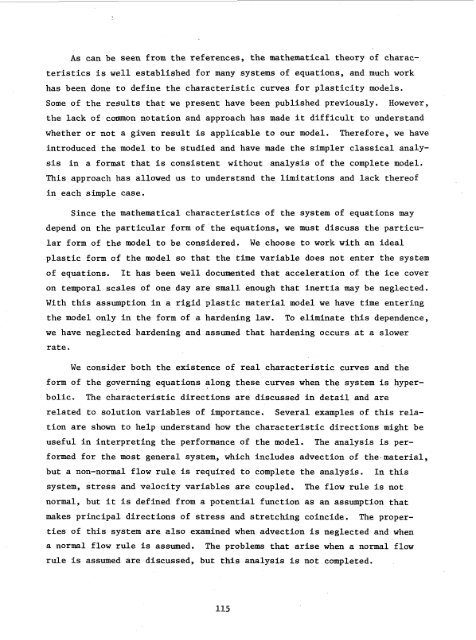AIDJEX Bulletin #40 - Polar Science Center - University of Washington
AIDJEX Bulletin #40 - Polar Science Center - University of Washington
AIDJEX Bulletin #40 - Polar Science Center - University of Washington
Create successful ePaper yourself
Turn your PDF publications into a flip-book with our unique Google optimized e-Paper software.
As can be seen from the references, the mathematical theory <strong>of</strong> characteristics<br />
is well established for many systems <strong>of</strong> equations, and much work<br />
has been done to define the characteristic curves for plasticity models.<br />
Some <strong>of</strong> the results that we present have been published previously. However,<br />
the lack <strong>of</strong> common notation and approach has made it difficult to understand<br />
whether or not a given result is applicable to our model. Therefore, we have<br />
introduced the model to be studied and have made the simpler classical analysis<br />
in a format that is consistent without analysis <strong>of</strong> the complete model.<br />
This approach has allowed us to understand the limitations and lack there<strong>of</strong><br />
in each simple case.<br />
Since the mathematical characteristics <strong>of</strong> the system <strong>of</strong> equations may<br />
depend on the particular form <strong>of</strong> the equations, we must discuss the particular<br />
form <strong>of</strong> the model to be considered. We choose to work with an ideal<br />
plastic form <strong>of</strong> the model so that the time variable does not enter the system<br />
<strong>of</strong> equations. It has been well documented that acceleration <strong>of</strong> the ice cover<br />
on temporal scales <strong>of</strong> one day are small enough that inertia may be neglected.<br />
With this assumption in a rigid plastic material model we have time entering<br />
the model only in the form <strong>of</strong> a hardening law. To eliminate this dependence,<br />
we have neglected hardening and assumed that hardening occurs at a slower<br />
rate.<br />
We consider both the existence <strong>of</strong> real characteristic curves and the<br />
form <strong>of</strong> the governing equations along these curves when the system is hyperbolic.<br />
The characteristic directions are discussed in detail and are<br />
related to solution variables <strong>of</strong> importance. Several examples <strong>of</strong> this relation<br />
are shown to help understand how the characteristic directions might be<br />
useful in interpreting the performance <strong>of</strong> the model. The analysis is performed<br />
for the most general system, which includes advection <strong>of</strong> the.materia1,<br />
but a non-normal flow rule is required to complete the analysis. In this<br />
system, stress and velocity variables are coupled. The flow rule is not<br />
normal, but it is defined from a potential function as an assumption that<br />
makes principal directions <strong>of</strong> stress and stretching coincide. The properties<br />
<strong>of</strong> this system are also examined when advection is neglected and when<br />
a normal flow rule is assumed. The problems that arise when a normal flow<br />
rule is assumed are discussed, but this analysis is not completed.<br />
115








